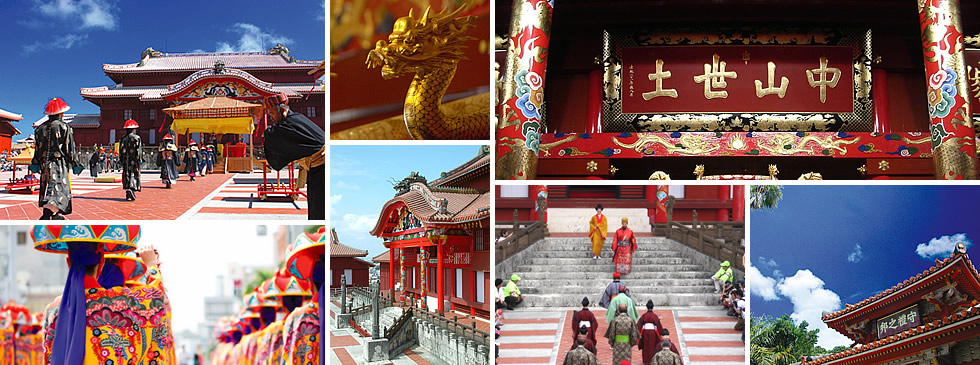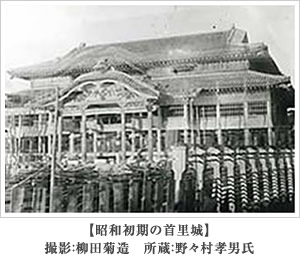About Shurijo Castle
Home > About Shurijo Castle


A World Heritage Site that Speaks of the Flourishing Ryukyu Kingdom
Shurijo Castle, the majestic center of politics, diplomacy, and culture of the Ryukyu Kingdom.
In the Battle of Okinawa in 1945, Shurijo Castle was left in ruins but in 1992, commemorating the 20th year since Okinawa’s reversion to Japan, Shurijo Castle was restored and opened as a national park.
Noted for its cultural and historical significance in the distinctive archeological style that combined the structural cultures of both China and Japan, as well as the high skills in the stonework, Shurijo Castle was registered as Japan’s 11th World Heritage Site in December of 2000.
The stately appearance of Shurijo Castle with its brilliant vermilion color speaks of the great history and culture of the proud kingdom, and symbolizes Okinawa.
About Shurijo Castle
 Shurijo Castle symbolizes the history and culture of Okinawa, and its history is that of the Ryukyu Kingdom itself.
Shurijo Castle symbolizes the history and culture of Okinawa, and its history is that of the Ryukyu Kingdom itself.
Shurijo Castle is situated on a small hill, surrounded by curving castle walls that protect numerous structures and facilities within. On the premises are numerous open squares and many sacred sites. These features are not limited to Shurijo Castle, but can also be seen at other castles in Okinawa, called Gusuku. The other Gusuku in Okinawa were defeated and ruined in their rivalry with Shurijo Castle, while Shurijo maintained the features of Gusuku and continued to flourish.
The Shurijo Castle grounds can be largely classified in inner and outer baileys or wards. The inner ward was completed in the early 15th century, and the outer ward was completed in mid-16th century. The Seiden and other buildings within the castle are built along the east-west axis, with its front facing west. These west-facing structures are distinctive of Shurijo Castle. Due to the long historical exchange with China and Japan, there are many features throughout Shurijo Castle showing the architectural cultures of both China and Japan, and the Seiden and Hokuden are notable in this aspect.
Shurijo Castle was the royal residence for the king and his family, and at the same time, it functioned as the Shuri Royal Government, a governing institution of the kingdom. It also was the core of religious networks that operated the rituals and ceremonies of the kingdom, executed by the priestesses dispatched at various locations throughout the land. In addition, performance arts and music flourished at Shurijo Castle and its surrounding areas, with many experts in the arts and crafts fields displaying and honing their skills. Shurijo Castle played was also the center of cultural arts in the kingdom.
In the spring of 1879, the king was banished from Shurijo Castle and Ryukyu Kingdom was annexed, and became Okinawa Prefecture. Later, Shurijo Castle was turned into a Japanese military post, and various schools and other facilities were housed here. During the 1930s, there were large-scale repair works, but the castle was completely destroyed in the attack by the American forces in 1945. After the war, the site became a campus for the University of the Ryukyus, but after the relocation of the university, restorations advanced and continues today. The restored Shurijo Castle is modeled after the castle from the 18th century and later. Shurijo Castle Site was registered as a World Heritage in December 2000.
-

In February of 2000, “Gusuku Sites and Related Properties of the Kingdom of Ryukyu” was registered under UNESCO World Heritage Site, the 11th of registered sites in all of Japan.
-

With respect and admiration, Shurijo Castle was looked up to and referred to as Ugushiku by the people of Shuri. The historical essays present episodes and information related to Shurijo Castle and its surrounding areas.
- Please read before your visit.
-
Shurijo Castle Park is situated atop a small hill that is 120 to 130 meters in altitude.
The hill overlooks the neighborhoods of Naha and this hill in Shuri was revered by the people.
As Shurijo Castle Park is restored and maintained as it was during the period of the Ryukyu Kingdom era,
there are numerous hills, steps, and stone-paved paths. On your visit, we recommend you wear comfortable footwear.
© Shurijo Castle Park All Rights Reserved.





